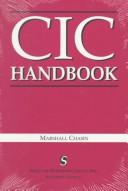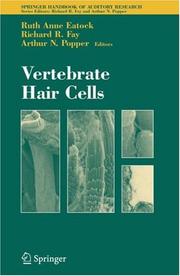| Listing 1 - 10 of 22 | << page >> |
Sort by
|
Book
ISBN: 0387968377 1461281571 146123560X Year: 1989 Publisher: New York (N.Y.) : Springer,
Abstract | Keywords | Export | Availability | Bookmark
 Loading...
Loading...Choose an application
- Reference Manager
- EndNote
- RefWorks (Direct export to RefWorks)
Amphibians --- Fishes --- Lateral line organs --- Mechanoreceptors --- Amphibia --- Evolution --- Congresses --- Physiology --- physiology --- congresses --- Congresses. --- congresses.

ISBN: 0736045171 9780736045179 Year: 2006 Publisher: Champaign, IL : Human Kinetics,
Abstract | Keywords | Export | Availability | Bookmark
 Loading...
Loading...Choose an application
- Reference Manager
- EndNote
- RefWorks (Direct export to RefWorks)
Striated muscle --- Anatomy. --- Physiology. --- Neuromuscular Junction --- Muscles --- Muscle, Skeletal --- Mechanoreceptors --- physiology --- anatomy & histology
Dissertation
Year: 1989 Publisher: Alblasserdam Kanters
Abstract | Keywords | Export | Availability | Bookmark
 Loading...
Loading...Choose an application
- Reference Manager
- EndNote
- RefWorks (Direct export to RefWorks)
High-Frequency Jet Ventilation --- Respiration, Artificial --- Mechanoreceptors --- Pulmonary Stretch Receptors --- methods --- physiology
Dissertation
Year: 1985 Publisher: Amsterdam Rodopi
Abstract | Keywords | Export | Availability | Bookmark
 Loading...
Loading...Choose an application
- Reference Manager
- EndNote
- RefWorks (Direct export to RefWorks)
Cardiac Output --- Mechanoreceptors --- Positive-Pressure Respiration --- Reflex --- Pulmonary Stretch Receptors --- Hemodynamics --- physiology
Book
ISBN: 0873227808 9780873227803 Year: 1996 Publisher: Champaign: Human kinetics,
Abstract | Keywords | Export | Availability | Bookmark
 Loading...
Loading...Choose an application
- Reference Manager
- EndNote
- RefWorks (Direct export to RefWorks)
This is the first book to combine under one cover classic studies and recent discoveries in muscle physiology. The author examines the structure of muscle and nerve and shows how structure is intimately related to function. He also discusses the cellular processes that take place when muscles work and how certain clinical disorders result from specific defects in muscle and nerve. This book collects all of the availabe knowledge on skeletal muscle anatomy and physiology into a logically organized, easy-to-follow reference
Muscle, Skeletal --- Mechanoreceptors --- Neuromuscular Junction --- Striated muscle --- Muscle strié --- physiology --- Physiology --- Physiologie --- Mechanoreceptors. --- Physiology. --- physiology. --- 612 --- -981460.jpg --- Spieren: anatomie --- Spieren: fysiologie --- Striped muscle --- Muscles --- Fysiologie --- Muscle strié --- 981460.jpg --- Striated muscle - Physiology. --- Muscle, Skeletal - physiology. --- Neuromuscular Junction - physiology.

ISBN: 1565934032 Year: 1996 Publisher: San Diego (Cal.) Singular Publishing Group
Abstract | Keywords | Export | Availability | Bookmark
 Loading...
Loading...Choose an application
- Reference Manager
- EndNote
- RefWorks (Direct export to RefWorks)
pleeg ook bijhorend boek: siso: 599.712 en awnr.: 2005/670.5 of 2005/671.5
Otorhinolaryngology --- Hoortoestellen --- Audiologie --- Otorinolaryngologie --- Erfelijkheidsleer --- Hair cells --- Hearing aids --- Otoacoustic emissions --- #KVHB:Audiologie --- #KVHB:Gehoorprothesen --- #KVHB:Gehoorstoornissen --- Emissions, Otoacoustic --- Bioacoustics --- Fitting of hearing aids --- Selection of hearing aids --- Cells of Corti --- Cochlear hair cells --- Corti's cells --- Corti's organ --- Mechanoreceptors --- Fitting --- Selection --- Hoortoestel

ISBN: 1280619066 9786610619061 0387317066 0387952020 1441929088 Year: 2006 Publisher: New York : Springer,
Abstract | Keywords | Export | Availability | Bookmark
 Loading...
Loading...Choose an application
- Reference Manager
- EndNote
- RefWorks (Direct export to RefWorks)
'Vertebrate Hair Cells' provides a current overview of the mechanosensory receptor cells of the vertebrate inner ear. Each chapter is written by experimentalists active in exploring a particular aspect of hair cell function, including development, mechanoelectrical transduction, and synaptic transmission. Hair cell research has entered an exciting phase in which the convergence of molecular/genetic and biophysical methods is stimulating a rapid expansion in our understanding of function. The intended audience ranges from senior undergraduates to scientists in the field of hair cell research. Ruth Anne Eatock is Professor in the Department of Otolaryngology at Baylor College of Medicine, Houston, Texas. Richard R. Fay is Director of the Parmly Hearing Institute and Professor of Psychology at Loyola University of Chicago. Arthur N. Popper is Professor in the Department of Biology and Co-Director of the Center for Comparative and Evolutionary Biology of Hearing at the University of Maryland, College Park.
Vertebrates --- Hair cells. --- Physiology. --- Cells of Corti --- Cochlear hair cells --- Corti's cells --- Corti's organ --- Mechanoreceptors --- Neurobiology. --- Otorhinolaryngology. --- Vertebrates. --- Life sciences. --- Biological and Medical Physics, Biophysics. --- Life Sciences, general. --- Biosciences --- Sciences, Life --- Science --- Vertebrata --- Chordata --- Ear, nose, and throat diseases --- ENT diseases --- Otorhinolaryngology --- Medicine --- Neurosciences --- Biophysics. --- Biological physics. --- Biological physics --- Biology --- Medical sciences --- Physics
Book
ISBN: 1281239429 9786611239428 0387733647 0387733639 Year: 2008 Publisher: New York : Springer,
Abstract | Keywords | Export | Availability | Bookmark
 Loading...
Loading...Choose an application
- Reference Manager
- EndNote
- RefWorks (Direct export to RefWorks)
The sensory hair cells in the inner ear and vestibular system convert mechanical stimuli, sound and motion into neural activity that is responsible for the sensations of hearing, motion and head position. In mammals, the loss of hair cells from acoustic overstimulation, ototoxic drugs and aging is irreversible, leading to a permanent loss of function. However, it is now clear that hair cells in other vertebrates are capable of regenerating and recovering partial or complete function. Moreover, partially damaged hair cells can undergo self-repair or be protected from traumatic insults by external compounds. Hair Cell Regeneration, Repair, and Protection provides a comprehensive survey of what is currently known about the regeneration, repair and protection of sensory hair cells and subsequent recovery of function in the auditory and vestibular system. The aim is to provide graduate students, postdoctoral fellows, clinicians and scientists in related disciplines with the biological bases of hair cells and with an understanding of the factors that contribute to their regeneration and repair. Table of Contents: Overview: Regeneration and repair Richard J. Salvi Morphological Correlates of Regeneration and Repair in the Inner Ear Jason R. Meyers and Jeffrey T. Corwin The recovery of function in the avian auditory system following ototrauma James C. Saunders and Richard J. Salvi Functional recovery following hair cell regeneration in birds Robert J. Dooling, Micheal L. Dent, Amanda M. Lauer, and Brenda M. Ryals Hair cell regeneration: Mechanisms guiding cellular proliferation and differentiation Elizabeth C. Oesterle and Jennifer S. Stone Protection and repair of inner ear sensory cells Andrew Forge and Thomas R. Van De Water Gene arrays, cell lines, stem cells, and sensory regeneration in mammalian ears Marcelo N. Rivolta and Matthew C. Holley About the editors: Richard J. Salvi, Center for Hearing and Deafness, University of Buffalo, NY. Arthur N. Popper is Professor in the Department of Biology and Co-Director of the Center for Comparative and Evolutionary Biology of Hearing at the University of Maryland, College Park. Richard R. Fay is Director of the Parmly Hearing Institute and Professor of Psychology at Loyola University of Chicago.
Hair cells. --- Hair cells --- Regeneration. --- Regeneration (Biology) --- Cells of Corti --- Cochlear hair cells --- Corti's cells --- Corti's organ --- Mechanoreceptors --- Neurobiology. --- Human physiology. --- Neurosciences. --- Human Physiology. --- Neural sciences --- Neurological sciences --- Neuroscience --- Medical sciences --- Nervous system --- Human biology --- Physiology --- Human body --- Neurosciences
Book
ISBN: 9060874560 9060874552 Year: 1975 Publisher: Lochem Tijdstroom
Abstract | Keywords | Export | Availability | Bookmark
 Loading...
Loading...Choose an application
- Reference Manager
- EndNote
- RefWorks (Direct export to RefWorks)
kinesitherapie --- oefentherapie --- pnf-methode --- bewegingsstoornissen --- Proprioception. --- Sense of Position --- Position Sense --- Position Senses --- Proprioceptions --- Sense, Position --- Senses, Position --- Mechanoreceptors --- 615.825 --- Revalidatie door beweging. Mechanotherapie --- Physiotherapy. Alternative treatments --- neuromotorische stoornissen --- Labyrinthine Sense --- Posture Sense --- Sense of Equilibrium --- Vestibular Sense --- Equilibrium Sense --- Sense, Labyrinthine --- Sense, Posture --- Sense, Vestibular --- Proprioception
Book
ISBN: 9811065268 981106525X Year: 2017 Publisher: Singapore : Springer Singapore : Imprint: Springer,
Abstract | Keywords | Export | Availability | Bookmark
 Loading...
Loading...Choose an application
- Reference Manager
- EndNote
- RefWorks (Direct export to RefWorks)
This book offers an essential introduction for all graduate students and researchers who are working on or interested in mechanotransduction using fruit flies as their model organisms. Designed for accessibility, it follows a simple five-chapter structure, beginning with a general introduction to mechanotransduction in physiology (Chapter 1) and some basic considerations on the principles behind mechanotransduction processes (Chapter 2). In turn, Chapters 3, 4 and 5 focus on mechanoreceptors in Drosophila melanogaster. Chapter 3 explains how the fly’s mechanosensitive cells (i.e. mechanoreceptors) contribute to its daily life, while Chapter 4 explores the ultrastructural and mechanical basis for the working mechanisms of various fly mechanoreceptors. Lastly, Chapter 5 elaborates on the structure, function and physiology of mechanosensitive molecules in fly mechanoreceptors. Accordingly, the book provides an overall framework, helping readers understand mechanosensory transduction, from the physiological level to the molecular level.
Medicine. --- Neurochemistry. --- Biochemistry. --- Animal models in research. --- Biomedicine. --- Biochemistry, general. --- Animal Models. --- Mechanoreceptors. --- Drosophila melanogaster. --- Mechanicoreceptors --- Sensory receptors --- Drosophila ampelophila --- Drosophila --- Laboratory animals. --- Animals, Experimental --- Animals, Laboratory --- Animals in research --- Experimental animals --- Lab animals --- Animal culture --- Laboratory organisms --- Working animals --- Animal experimentation --- Biological chemistry --- Chemical composition of organisms --- Organisms --- Physiological chemistry --- Biology --- Chemistry --- Medical sciences --- Biochemistry --- Neurosciences --- Composition --- Biological models --- Laboratory animals --- Research
| Listing 1 - 10 of 22 | << page >> |
Sort by
|

 Search
Search Feedback
Feedback About UniCat
About UniCat  Help
Help News
News